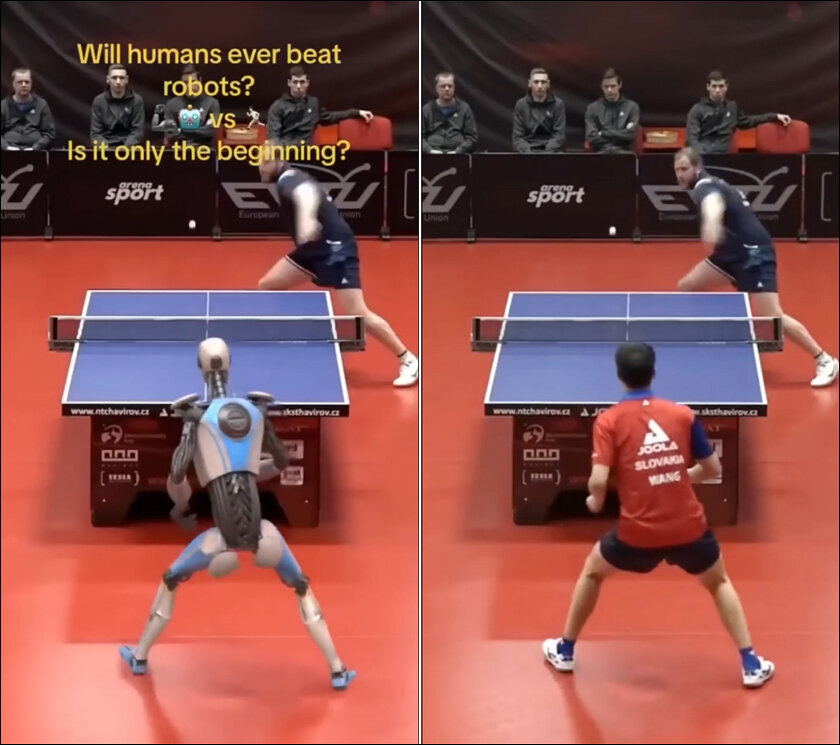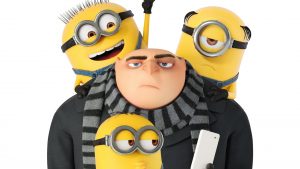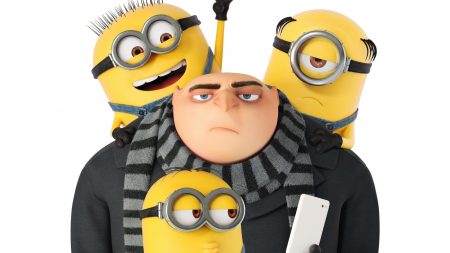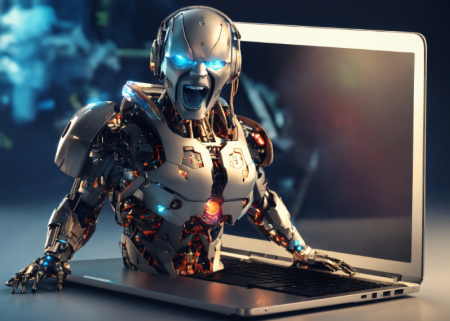The most watched viral video this year is an altered deep fake table tennis clip, finds Satyen K. Bordoloi as he decodes what this means for us all.
Unless you’re a digital sanyasi, you’ve seen this summer’s blockbuster social media hit. A human is playing ping pong with a robot. The robot moves with unbelievably fluidity. In the final moments, the bot nonchalantly – almost insultingly – hits a deft cross its human opponent can’t reach.
Appearing sometime in July, the most popular upload of this video on YouTube has 103 million views so far. Dozens of others have reposted it, getting millions more views in aggregate. It’s popped up on all other social media. The downloaded clip is being shared on messaging apps. Together it could have raked in views reaching a billion or more becoming one of the most watched videos on the planet ever.

People in the YouTube video’s comment section are freaking out. “I can’t get over how boss the robot was in his last shot. Talk about mic drop!” wrote one as another chimed in: “I honestly dont think human know what they’re doing when they creates robots” while yet another was an alarmist: “When that robot beat the human in ping pong, you just witnessed a pivotal moment in human history. It was no less than that. And no one realizes this is going on.”
There’s just one problem. That video is fake. It’s edited from an actual clip of a game between two humans using easy-to-use AI video editors. In it you select a preloaded avatar, instruct the software to paste it on a particular thing on a clip – in this case a human – and voila, you have altered silicon in seconds. Instead of the winning human, the human editing the clip could have chosen to make the losing human a robot. But where’s the fun and fear-mongering in a defeated robot?
The irony is that the original video of humans playing is itself viral with 22 million views. However, it did not seep into the zeitgeist. Adding insult to injury is that it isn’t difficult to assess the fakeness of the altered video. All you need to do is look at the reflection of the ‘robot’.
On the face of it, the video is fun, and harmless. It would have been had it been labelled as deepfake like some creators do. But because it pretends to be real, it – as the comments attest – misleads viewers. In a world where fear mongering against Artificial Intelligence is a global hobby, videos like this could cause harm.
Yet, it unmistakably underlines the power of AI.
WHAT CAN AI DO:
In 2008, a similar, allegedly found footage of Bruce Lee playing table tennis with a nunchaku had gone viral. It made sense, Bruce Lee was known for his agility and the grainy video seemed plausible. This video keeps propping up every few months in different circles. And almost never is it clarified that it is actually an advertisement for the launch of the Nokia N96 Limited Edition Bruce Lee cell phone. The video is so well produced, that it is a victim of its own success.
Though Bruce Lee couldn’t save Nokia (what was needed was Mr. Lee’s legendary agility inside the phone, which the iPhone launched by Apple a year earlier provided), this ad has become a cultural icon. Perhaps this video subconsciously inspired the robot vs. human clash video which is rapidly becoming a cultural phenomenon in its own right.
What is important to note is the difference between the two clips. The Bruce Lee clip was created by a professional ad agency after much effort and cost, including expensive special effects. The robot vs. human clip was made in one of the many AI video editing tools that have come up in the last year. All you need to do is choose the avatar to replace something in an existing clip and voila, the AI does the rest. This video didn’t take more than a few minutes and cost nothing to create.
Till mid-2022, AI did a lot for you – translations, search, maps, turn speech to text etc. – but most of us didn’t see it do these. A month later i.e. July 2022, the world was jolted to its potential by Dall-E – a prompt to image generator. But it took ChatGPT 6 months later, created by the same company OpenAI, to make AI seep into the zeitgeist. In just 13 months of the first released generative AI program, it can edit, create, sharpen and colourise video and images, remove or add unwanted objects and even people from them, and most stunningly: do all this using just word prompts.
This is good for creators. As a screenwriter, I have ideas no one currently wants to fund. But with AI advancing so rapidly, in the next few years, I hope to become a no-camera filmmaker, the type I wrote about in this Sify article. It was said digital cameras would democratize filmmaking. It did to an extent. What truly will democratize filmmaking is Artificial Intelligence.

AI TURBOCHARGES PORNOGRAPHY AND PATRIARCHY:
The problem with humans is that no matter how brilliant or profound a new invention, we will find frivolous, or harmful uses of it. Porn made by artificial intelligence is already a rage on the web. Again, it may seem harmless, after all these images and videos are not of real people. But the flawless skin and features of these AI creations – put unrealistic expectations in the minds of the young about love, sex, emotions, attachments etc. This has led to an increase in incels happy to sit at home watching these ‘creations’, with now subservient AI girlfriends being added to the trend, instead of trying to go into the real world and form bonds with real partners.
In India, AI editing will turbocharge patriarchal divides. Many of the AI pornography sites give you the option to make anyone nude. Just insert an image of a clothed person, and voila the AI vomits out a full nude image from it. Images, even actual porn clips featuring celebrity faces are already popular. But the bigger danger is when it becomes like acid in the hands of poorly raised men.
This is a story repeated every day in millions of corners of India. Boy meets girl. Girl may or may not like boy. If girl likes boy and tolerates him enough to marry and boost his fragile ego, all is well. But if girl refuses his marriage proposal, or repulses his advances, the boy is enraged. He does his best to tarnish her reputation. If the girl is looking for other marriage prospects, the boy spreads lies about her. In worst-case scenarios, such men have been known to circulate fake nudes or throw acid.
‘Meri nahi toh kisi aur ki bhi nahi’ – if not mine, she’ll be no one else’s – is the badge of ‘love’ these Arjun Reddy aka Kabir Singh type incels wear on their sleeves. They are proud of spoiling the future of a girl they claim to ‘love’. Imagine the power of AI in the hands of such man-children?
Then there’s the danger of deepfake voices and videos used to scam people. Imagine your tech-challenged father or mother getting a short AI-edited video or audio clip on WhatsApp where you are begging them to get you out of jail, sent by a person claiming to be a lawyer who says he needs a few lakh rupees to do so. As I wrote in Sify earlier, these kinds of scams are already happening in advanced nations. The reason it’s not common in India yet is because these AI creation tools have not been trained in Indian languages, as they have been in English.
THE TRUTH ABOUT GOOD FAKES:
What we forget when talking about fake news, disinformation, misinformation and conspiracy theories, is that they are not utter lies. The foundation of their fake narratives is based on some bits of truth. The anti-vaxxers create conspiracy theories against vaccines because vaccines have harmed people in the distant past – the most famous being the Polio vaccine in its early days. Like these examples, even AI-generated videos as in the ping pong one, are based on a real clip with only a small part being faked.
It is this enmeshing with the truth and the real that makes these videos made by AI go viral. Any kind of countermeasures that we take, will hence need to keep this in mind.
At times, today’s fakes are predictions of the future. If you have seen the actual videos made by Boston Dynamics – one of the leading robotics companies in the world – you will realise that robots playing table tennis are not a question of ‘if’, but ‘when’. In under a decade – in all likelihood – you’ll actually have a robot playing table tennis to approximate the dexterity of humans.
When that day comes, you know what will be most ironic? Humans would have become so used to robot narratives – real and fake – that that real video of an actual robot playing against a human will not generate a fraction of the interest or virality that its fake version generates today. And that is the biggest tragedy of our times: humans falling for fake miracles in a world full of real miracles created by science.
In case you missed:
- Rise of the Robolympics: When R2-D2 Meets Rocky Balboa
- Forget Smart Homes – Welcome to Your ‘Feeling’ Home
- When AI Meets Metal: How the Marriage of AI & Robotics Will Change the World
- PSEUDO AI: Hilarious Ways Humans Pretend to be AI to Fool You
- DeepSeek not the only Chinese model to upset AI-pple cart; here’s dozen more
- Anthropomorphisation of AI: Why Can’t We Stop Believing AI Will End the World?
- How Lionsgate-Runway Deal Will Transform Both Cinema & AI
- The Great Data Famine: How AI Ate the Internet (And What’s Next)
- Susan Wojcicki: The Screaming Legacy of The Quiet Architect of the Digital Age
- What are Text-to-Video Models in AI and How They are Changing the World









